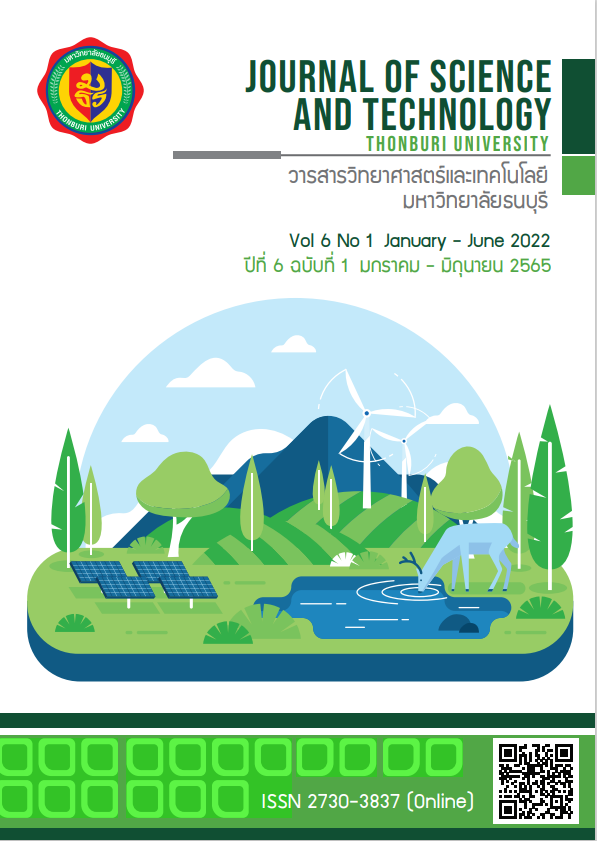การวิเคราะห์ความเสถียรของระบบไฟฟ้าโซลาร์เซลล์ที่เชื่อมต่อกับกริดสามเฟส
คำสำคัญ:
การเพิ่มความนำตรรกะคลุมเครือ, โมเดลทำนายล่วงหน้า, จุดจ่ายกำลังสูงสุด, ความผิดเพี้ยนฮามอนิกส์, ตัวประกอบกำลังบทคัดย่อ
งานวิจัยนี้นำเสนอการวิเคราะห์ความเสถียรของระบบไฟฟ้าโซลาเซลล์ที่เชื่อมต่อกับกริดสาม เฟสด้วยอินเวอร์เตอร์สามเฟสแบบขั้นตอนเดียวโดยการใช้อัลกอริธึมการเพิ่มความมนำตรรกะคลุมเครือ เพื่อควบคุมกระแสไฟฟ้าอ้างอิงร่วมกับโมเดลทำนายล่วงหน้าในการควบคุมจุดจ่ายก าลังสูงสุดของเซลล์ แสงอาทิตย์และควบคุมการเชื่อมต่อกับกริดเพื่อให้ระบบสามารถติดตามจุดจ่ายกำลังสูงสุดเมื่อการแผ่รังษีแสงอาทิตย์และอุณหภูมิเปลี่ยนแปลงอย่างทันทีทันใด โดยที่ระบบสามารถควบคุมผลรวมความ ผิดเพี้ยนฮาร์โมนิกไม่ให้เกินค่ามาตรฐาน รักษาตัวประกอบก าลังของระบบให้เท่ากับ 1 รวมถึงสามารถ รักษาการเชื่อมต่อกับกริดได้ จากผลการจำลองการทำงานแสดงให้เห็นว่าระบบที่นำเสนอสามารถรักษา ตัวประกอบกำลังเท่ากับ 1 ตลอดเวลา โดยที่ผลรวมความผิดเพี้ยนฮามอนิกส์เท่ากับ 2.5 เปอร์เซ็นต์ เวลาในการเข้าสู่จุดจ่ายกำลังสูงสุด 0.02 วินาที สามารถติดตามจุดจ่ายกำลังสูงสุดเมื่อการฉายรังษีและอุณหภูมิมีการเปลี่ยนแปรงอย่างรวดเร็ว
เอกสารอ้างอิง
H. J. El-Khozondar, R. J. El-Khozondar, K. Matter, and T. Suntio (2016). A review study of photovoltaic array maximum power tracking algorithms: Renewables Wind Water and Solar, 3(1).
M. N. Bhukya and V. R. Kota (2019). A quick and effective MPPT scheme for solar power generation during dynamic weather and partial shaded conditions: Engineering Science and Technology an International Journal, 22( 3), 869-884.
V. Jately, B. Azzopardi, J. Joshi, B. Venkateswaran V, A. Sharma, and S. Arora (2021). Experimental Analysis of hill-climbing MPPT algorithms under low irradiance levels: Renewable and Sustainable Energy Reviews, 50, 111467.
L. Jia, X. Ruan, W. Zhao, Z. Lin, and X. Wang (2018). An Adaptive Active Damper for Improving the Stability of Grid-Connected Inverters Under Weak Grid: IEEE Transactions on Power Electronics, 33(11), 9561-9574.
A. M. A. Haidar and N. Julai (2019). An improved scheme for enhancing the ride-through capability of gridconnected photovoltaic systems towards meeting the recent grid codes requirements: Energy for Sustainable Development, 50, 38-49.
N. S. Ahmad, T.-W. Tsai, and Y.-M. Chen (2020). Single-Phase Grid-Connected Inverters With Simplified SPWM Control: IEEE Open Journal of Power Electronics, 1, 170-179.
J. Ahmed and Z. Salam (2018). An Enhanced Adaptive P&O MPPT for Fast and Efficient Tracking Under Varying Environmental Conditions: IEEE Transactions on Sustainable Energy, 9(3), 1487-1496.
M. A. Abdullah, T. Al-Hadhrami, C. W. Tan, and A. H. Yatim (2018). Towards Green Energy for Smart Cities Particle Swarm Optimization Based MPPT Approach: IEEE Access, 6, 58427-58438.
M. M. Ahmed, W. S. Hassanein, N. A. Elsonbaty, and M. A. Enany (2020). Proposing and evaluation of MPPT algorithms for high-performance stabilized WIND turbine driven DFIG: Alexandria Engineering Journal, 59(6), 5135-5146.
A. Ali, K. Almutairi, S. Padmanaban, V. Tirth, S. Algarni et al (2020). Investigation of MPPT Techniques Under Uniform and Non-Uniform Solar Irradiation Condition–A Retrospection: IEEE Access, 8, 127368-127392.
C. H. Hussaian Basha and C. Rani (2020). Performance Analysis of MPPT Techniques for Dynamic Irradiation Condition of Solar PV: International Journal of Fuzzy Systems, 22(8), 2577-2598.
A. Kihal, F. Krim, A. Laib, B. Talbi, and H. Afghoul (2019). An improved MPPT scheme employing adaptive integral derivative sliding mode control for photovoltaic systems under fast irradiation changes: ISA Trans, 87, 297-306.
J. Macaulay and Z. Zhou (2018). A Fuzzy Logical-Based Variable Step Size P&O MPPT Algorithm for Photovoltaic System: Energies, 11(6), 1340.
M. Gunasekaran, V. Krishnasamy, S. Selvam, D. J. Almakhles, and N. Anglani (2020). An Adaptive Resistance Perturbation Based MPPT Algorithm for Photovoltaic Applications: IEEE Access, 8, 196890-196901.
A. Harrag and S. Messalti (2019). IC-based Variable Step Size Neuro-Fuzzy MPPT Improving PV System Performances: Energy Procedia, 57, 362-374.
A. Loukriz, M. Haddadi, and S. Messalti (2016). Simulation and experimental design of a new advanced variable step size Incremental Conductance MPPT algorithm for PV systems: ISA Trans, 62, 30-38.
M. Jiang, M. Ghahremani, S. Dadfar, H. Chi, Y. N. Abdallah, and N. Furukawa (2021). A novel combinatorial hybrid SFL–PS algorithm based neural network with perturb and observe for the MPPT controller of a hybrid PV-storage system: Control Engineering Practice, 114, 104880.
N. Priyadarshi, S. Padmanaban, J. B. Holm-Nielsen, F. Blaabjerg, and M. S. Bhaskar (2020). An Experimental Estimation of Hybrid ANFIS–PSO-Based MPPT for PV Grid Integration Under Fluctuating Sun Irradiance: IEEE Systems Journal, 14(1), 1218-1229.
M. Sujith and S. Padma (2020). Implementation of PSOANN Optimized PI Control Algorithm for Shunt Active Filter: Computer Modeling in Engineering & Sciences, 122(3), 863-888.
K. Yung Yap, C. R. Sarimuthu, and J. Mun-Yee Lim (2020). Artificial Intelligence Based MPPT Techniques for Solar Power System: Journal of Modern Power Systems and Clean Energy, 8(6), 1043-1059.
O. Abdel-Rahim, N. Alamir, M. Orabi, and M. Ismeil (2020). Fixed-frequency phase-shift modulated PVMPPT for LLC resonant converters: Journal of Power Electronics, 20(1), 279-291.
K. Ali, L. Khan, Q. Khan, S. Ullah, and N. Ali (2021). Neurofuzzy robust backstepping based MPPT control for photovoltaic system: TURKISH JOURNAL OF ELECTRICAL ENGINEERING & COMPUTER SCIENCES, 29(1), 421-436.
S. Bhattacharyya, D. S. Kumar P, S. Samanta, and S. Mishra (2021). Steady Output and Fast Tracking MPPT (SOFT-MPPT) for P&O and InC Algorithms: IEEE Transactions on Sustainable Energy, 12(1), 293-302.
M. Y. Ali Khan, H. Liu, Z. Yang, and X. Yuan (2020). A Comprehensive Review on Grid Connected Photovoltaic Inverters: Energies, 13(16), 4185.
R. Errouissi, A. Al-Durra, and S. M. Muyeen (2016). A Robust Continuous-Time MPC of a DC–DC Boost Converter Interfaced With a Grid-Connected Photovoltaic System: IEEE Journal of Photovoltaics, 6(6), 1619-1629.
H. Liao, X. Zhang, and Z. Ma (2021). Robust dichotomy solution-based model predictive control for the grid-connected inverters with disturbance observer: CES Transactions on Electrical Machines and Systems, 5(2), 81-89.
R. O. Ramirez, C. R. Baier, F. Villarroel, J. R. Espinoza, J. Pou, and J. Rodriguez (2020). A Hybrid FCS-MPC With Low and Fixed Switching Frequency Without Steady-State Error Applied to a GridConnected CHB Inverter: IEEE Access, 8, 223637- 223651.
W. Alhosaini, Y. Wu, and Y. Zhao (2019). An Enhanced Model Predictive Control Using Virtual Space Vectors for Grid-Connected Three-Level Neutral-Point Clamped Inverters: IEEE Transactions on Energy Conversion, 34(4), 1963-1972.
M. Aourir, A. Abouloifa, I. Lachkar, C. Aouadi, F. Giri, and J. M. Guerrero (2020). Nonlinear control and stability analysis of single stage grid-connected photovoltaic systems: International Journal of Electrical Power & Energy Systems, 115.
M. A. Ebrahim, A. Osama, K. M. Kotb, and F. Bendary (2019). Whale inspired algorithm based MPPT controllers for grid-connected solar photovoltaic system: Energy Procedia, 162, 77-86.
X. Ge, F. W. Ahmed, A. Rezvani, N. Aljojo, S. Samad, and L. K. Foong (2020). Implementation of a novel hybrid BAT-Fuzzy controller based MPPT for grid-connected PV-battery system: Control Engineering Practice, 98, 104380
ดาวน์โหลด
เผยแพร่แล้ว
รูปแบบการอ้างอิง
ฉบับ
ประเภทบทความ
สัญญาอนุญาต

อนุญาตภายใต้เงื่อนไข Creative Commons Attribution-NonCommercial-NoDerivatives 4.0 International License.




